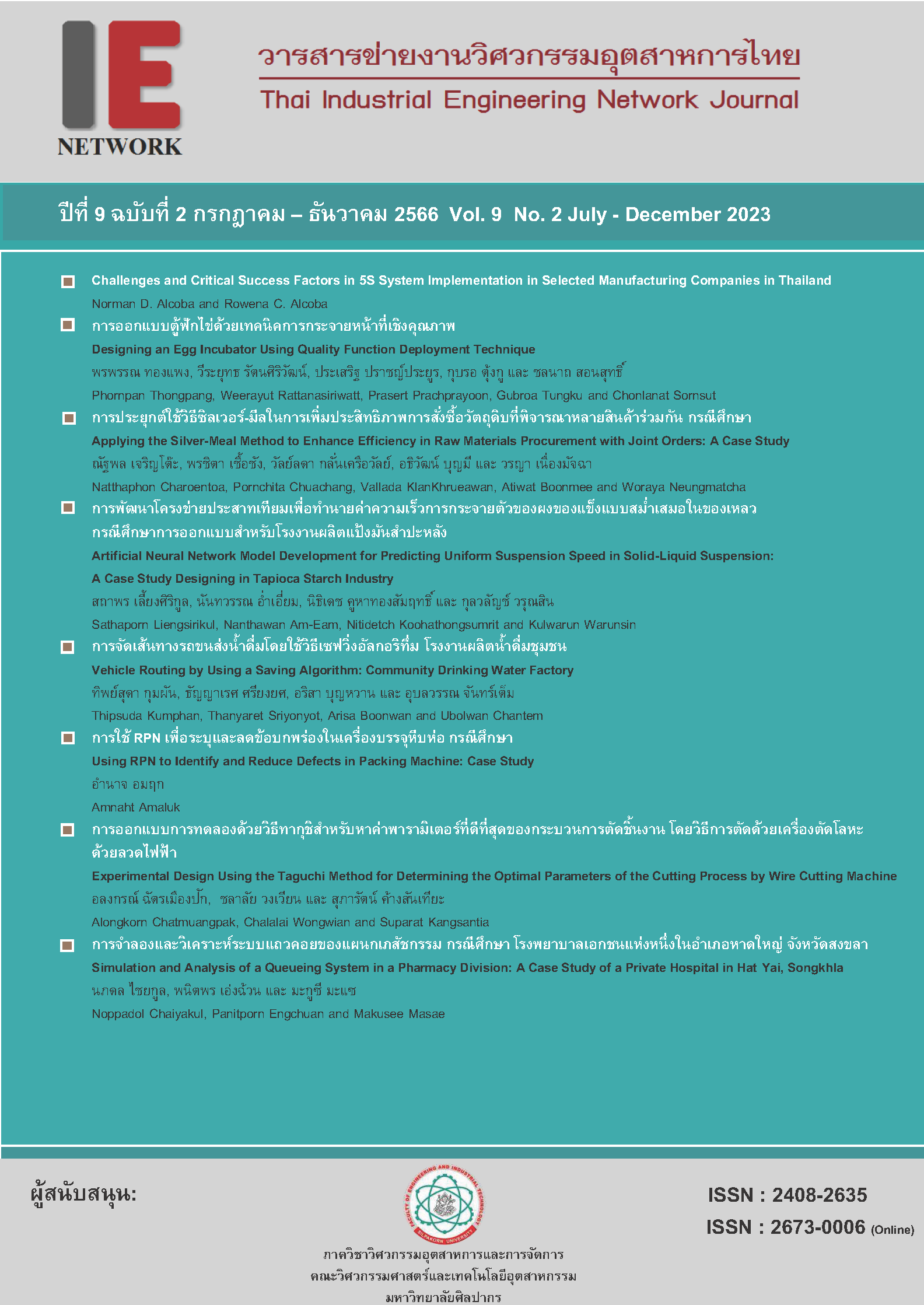Artificial Neural Network Model Development for Predicting Uniform Suspension Speed in Solid-Liquid Suspension: A Case Study Designing in Tapioca Starch Industry
Main Article Content
Abstract
The important factors in controlling the quality of the solid-liquid mixing process in a mixing tank for solid-liquid suspension are the optimum and sufficient rotational speed that can induce a uniform suspension of solids in the liquid. To design an optimum rotational speed, one must understand the deep understanding theory of liquid mixing technology and utilize complex mathematical equations for calculation. Designers need practical experience in real-world testing to analyze and predict accurately, reducing the complexity while maintaining the practical validity of the design. The objective of this research is to develop an artificial neural network model in the form of variable relationships for screening suitable factors and predicting the rotational speed to determine uniform suspension speed in the mixing tank. The research consists of two steps: Step 1: Developing an artificial neural network to analyze 8 relevant factors and identify suitable factors for design. Step 2: Developing an artificial neural network to predict the rotational speed for achieving uniform suspension speed in the mixing tank. The research utilizes data from the actual design and operation of a solid-liquid mixing tank in the industrial sector. This involves 1440 data points for Step 1 and 630 data points for Step 2. The results showed that the developed artificial neural network model employs backpropagation learning. In Step 1, the neural network model can accurately analyze and decide on suitable factors with an R2 value of 1.0 and an error of 0%. For Step 2, the neural network model can accurately predict the rotational speed with an R2 value of 0.91 and MAPE of 4.47%. Therefore, utilizing the artificial neural network as a model for designing the mixing process that aims to achieve uniform suspension of solid powder in a liquid can be as effective as designs created by professionals specializing in fluid mixing system design.
Article Details

This work is licensed under a Creative Commons Attribution-NonCommercial-NoDerivatives 4.0 International License.
บทความ ข้อมูล เนื้อหา รูปภาพ ฯลฯ ที่ได้รับการตีพิมพ์ในวารสารฯ ถือเป็นลิขสิทธิ์ของวารสารฯ หากบุคคลหรือหน่วยงานใดต้องการนำทั้งหมดหรือส่วนหนึ่งส่วนใดไปเผยแพร่ต่อหรือเพื่อกระทำการใดๆ จะได้รับอนุญาต แต่ห้ามนำไปใช้เพื่่อประโยชน์ทางธุรกิจ และห้ามดัดแปลง
References
James Y Oldshue. Fluid mixing technology. New York: McGraw-Hill; 1983.
N Harnby, M F Edwards, A W Nienow. Mixing in the Process Industrials. British: A division of Reed Educational and Professional Publishing Ltd; 1985.
Edward L Paul, Suzanne M Kresta, Victor A Atiemo-Obeng. Handbook of Industrial Mixing. Canada: John Wiley & Sons Inc; 2004.
ขวัญชัย สินทิพย์สมบูรณ์, วิศิษฏ์ จาตุรมาน. กลศาสตร์ของไหล. พิมพ์ครั้งที่ 1. กรุงเทพฯ: ซีเอ็ดยูเคชั่น; 2552.
สมาน เจริญกิจพูลผล, มนตรี พิรุณเกษตร. กลศาสตร์ของไหลฉบับเสริมประสบการณ์. พิมพ์ครั้งที่ 1. กรุงเทพฯ: ซีเอ็ดยูเคชั่น; 2556.
Suzanne M Kresta, Arthur W Etchells III, David S Dickey, Victor A Atiemo-Obeng. Advances in Industrial Mixing. Canada: John Wiley & Sons Inc; 2016.
Choe Earn Choong, Shaliza Ibrahim, Ahmed El-Shafie. Artificial Neural Network (ANN) model development for predicting just suspension speed in solid-liquid mixing system. Flow Measurement and Instrumentation.2020; Volume71: 101689
Shaliza Ibrahimb, Choe Earn Choonga, Ahmed El-Shafiea. Sensitivity analysis of artificial neural networks for just-suspension speed prediction in solid-liquid mixing systems: Performance comparison of MLPNN and RBFNN. Advanced Engineering Informatics. 2019; Volume39; Pages 278-291
Jolanta Szoplik, Marta Ciuksza. Mixing time prediction with artificial neural network model. Chemical Engineering Science.2021; Volume246: 116949
กอบเกียรติ สระอุบล. เรียนรู้ Ai Deep Learning ด้วย Python. พิมพ์ครั้งที่ 1. กรุงเทพฯ: หสม สำนักพิมพ์ อินเตอร์มีเดีย; 2565.
วิริทธิ์พล เกษมสุข. การพัฒนาระบบโครงข่ายประสาทเทียมสำหรับทำนายจำนวนวันหยุดงานจากการเกิดอุบัติเหตุจากการทำงาน [วิทยานิพนธ์ ปริญญาวิทยาศาสตรมหาบัณฑิต]. ชลบุรี; มหาวิทยาลัยบูรพา; 2565
ศศิชา บุญเก่า. การจับความรู้สึกของคนจากใบหน้าด้วยเทคนิคปัญญาประดิษฐ์ [วิทยานิพนธ์ ปริญญาวิศวกรรมศาสตรมหาบัณฑิต]. กรุงเทพฯ; มหาวิทยาลัยเกษตรศาสตร์; 2562
วชิราภรณ์ แก้วมาตย์, สุรชัย จันทร์จรัส. การใช้โครงข่ายประสาทเทียมในการพยากรณ์ดัชนีราคาหลักทรัพย์. วารสารวิจัย มข. 2556; 108-118
เชาวน์ หิรัยตียะกุล. การประยุกต์ใช้โครงข่ายประสาทเทียมสำหรับการเตือนภัยน้ำท่วม. นครราชศรีมา: มหาวิทยาลัยเทคโนโลยีสุรนารี; มิถุนายน 2549: SUT7-712-46-12-41
จีราวุธ วารินทร์. มือใหม่ Python เก่งได้ใน 30 วัน. พิมพ์ครั้งที่ 1. กรุงเทพฯ: บริษัท พงษ์วรินการพิมพ์ จำกัด; 2565.
Koohathongsumrit N, Luangpaiboon P. An Integrated FAHP–ZODP Approach for Strategic Marketing Information System Project Selection. Managerial and Decision Economics. 2022; Vol. 43: 1792-1809


